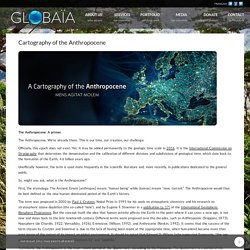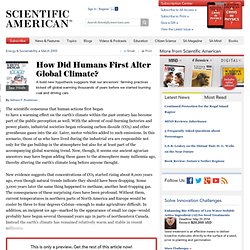

A Cartography of the Anthropocene. The Anthropocene: A primer.

The Anthropocene. We’re already there. This is our time, our creation, our challenge. Officially, this epoch does not exist. Yet. The Anthropocene Project. Anthropocenic Research Forum. Subcomission on Quaternary Stratigraphy, ICS » Working Groups. You are in: Home » Working Groups What is the 'Anthropocene'? - current definition and status The 'Anthropocene' is a term widely used since its coining by Paul Crutzen and Eugene Stoermer in 2000 to denote the present time interval, in which many geologically significant conditions and processes are profoundly altered by human activities.
Working group convenor: Dr Jan Zalasiewicz (Leicester) e-mail: jaz1@le.ac.uk Members: Working Group communications: Links to publications and communications on the 'Anthropocene' Archaeologists say that the 'Anthropocene' is here - but it began long ago. Geology. Antonio Stoppani's Anthropozoic. Edited by Etienne Turpin + Valeria Federighi Images Lisa Hirmer Lisa Hirmer, Untitled, from Sudbury Slag, 2012 Introduction The Italian geologist Antonio Stoppani is a remarkable but little known figure in the history of science and the theoretical humanities. Welcome to the Anthropocene. How Did Humans First Alter Global Climate?
The scientific consensus that human actions first began to have a warming effect on the earth's climate within the past century has become part of the public perception as well.

With the advent of coal-burning factories and power plants, industrial societies began releasing carbon dioxide (CO2) and other greenhouse gases into the air. Later, motor vehicles added to such emissions. In this scenario, those of us who have lived during the industrial era are responsible not only for the gas buildup in the atmosphere but also for at least part of the accompanying global warming trend. Now, though, it seems our ancient agrarian ancestors may have begun adding these gases to the atmosphere many millennia ago, thereby altering the earth's climate long before anyone thought.
New evidence suggests that concentrations of CO2 started rising about 8,000 years ago, even though natural trends indicate they should have been dropping. Select an option below: Customer Sign In. Enter the Anthropocene. Elizabeth Kolbert from Geologic City: A Field Guide to the GeoArchitecture of New York, smudge studio 2011 The path leads up a hill, across a fast-moving stream, back across the stream, and then past the carcass of a dead sheep. In my view it’s raining, but here in the Southern Uplands of Scotland, I am told, this counts only as a light drizzle, or smirr. Just beyond the final switchback, there’s a waterfall, half shrouded in mist, and an outcropping of jagged rock.
The rock has bands that run vertically, like a layer cake that’s been tipped on its side. The stripe was laid down some 440 million years ago, as sediments slowly piled up on the bottom of an ancient ocean. Stratigraphers like Zalasiewicz are, as a rule, hard to impress. So it’s disconcerting to learn that many stratigraphers have come to believe we are such an event—that human beings have so altered the planet, just in the last century or two, that we’ve ushered in a new epoch: the Anthropocene. Back to top ↑ Anthropocene – Nature and Technology in the Age of Humans (2014/2015) - Rachel Carson Center for Environment and Society - LMU Munich.
Location: Deutsches Museum Together with the Deutsches Museum, the Rachel Carson Center is currently planning a major special exhibition on the topic of the Anthropocene under the working title “Anthropocene—Nature and Technology in the Age of Humans,” scheduled to open in fall 2014. The endeavor is based on a proposal by Prof. Dr. Reinhold Leinfelder developed during his fellowship at the Rachel Carson Center and the book Menschenzeit by Christian Schwägerl.
Both Leinfelder, in his function as affiliated Carson Professor, and Schwägerl are involved in the conceptualization process of the exhibition. Coined by the atmospheric chemist and Nobel Prize laureate Paul J. In the tradition of the Deutsches Museum, the exhibition will show both historical artifacts and current objects from scientific and industrial laboratories and integrate the audience by means of interactive demonstrations and direct participation through digital media. Detailed Exhibition Description (pdf, 3 MB) Project_leinfelder.